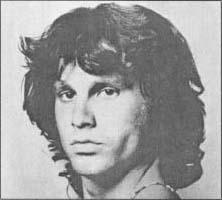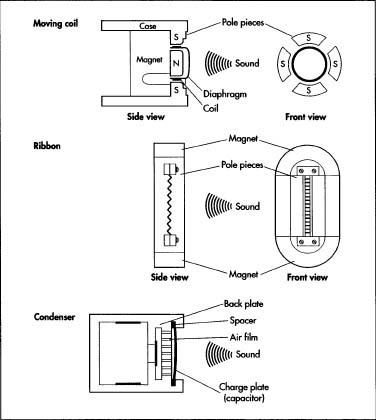Microphone
Background
A microphone is a device that converts mechanical energy waves or sound into electrical energy waves. Speaking into a microphone excites (moves) a diaphragm that is coupled to a device that creates an electrical current proportional to the sound waves produced.
Microphones are a part of everyday life. They are used in telephones, transmitters for commercial radio and television broadcast, amateur radio, baby monitors, tape recorders, motion pictures, and public address systems. There are many different types of microphones—the design depending upon the application. Sound recording, radio and television, and motion picture studios use ribbon or condenser type microphones because of their high quality reproduction of sound. Public address systems, telephones, and two-way radio communications systems can use carbon, ceramic, or dynamic microphones because of their versatility and low cost.
History
The first microphone was invented as a telephone transmitter by Alexander Graham Bell in 1876. It was a liquid device that was not very practical. In 1886, Thomas Alva Edison invented the first practical carbon microphone. The carbon microphone was used for radio transmissions and extensively in telephone transmitters until the 1970s when they were replaced by piezoelectric ceramic elements.
The carbon microphone had a limited frequency range, and would not reproduce music effectively. In 1916, the condenser microphone was developed by E. C. Wente of Bell Laboratories. The condensor microphone required an amplifier built within the microphone to pick up the faint signals. Condensor microphones were used for radio broadcasting and the first generation of sound motion pictures.
A major breakthrough in microphone technology would come in 1931 with the invention of the moving-coil or dynamic microphone by Wente and A. C. Thuras of Bell Laboratories. The dynamic microphone has a lower noise or distortion level than that of the carbon microphone and required no power to operate. The dynamic microphone is in extensive use today in all areas of communication and entertainment.
In 1931, the ribbon microphone was introduced by RCA, and became one of the most widely used microphones for the vocal recording and broadcasting industries. It was considered by many as the most natural sounding microphone ever made. The ribbon microphone was very heavy, about 8 lb (3.6 kg), and could easily be damaged by shock or blowing into it. Variations of the ribbon microphone are still use today.
The ceramic or crystal microphone was invented 1933 by the Astatic Corporation when C. M. Chorpening and F. H. Woodworth found that they could make a microphone out of Rochelle salts or piezoelectric crystals. They found that when sound waves struck these crystals, they vibrated and created an electrical current.
Raw Materials
Depending upon the type of microphone, raw materials may vary. Permanent magnets are generally made from a neodymium iron boron compound. The voice coil and cable are made from copper wire. Plastic is used for cable insulation. The case is usually made from aluminum sheet and sometimes plastic.
Design
The dynamic or moving-coil microphone consists of a thin plastic diaphragm attached to a voice coil. The voice coil consists of many turns of very small diameter insulated copper wire wound on a bobbin. Surrounding the voice coil is a permanent magnet. Sound causes the diaphragm to vibrate, which causes the voice coil to move on its axis. This movement induces a voltage in the coil and creates a varying electrical current proportional to the sound to flow through the coil. This induced current is the audio signal.
The condenser or capacitor microphone consists of two metal plates spaced slightly apart. These two plates act as a capacitor. A capacitor is a device that stores an electrical charge. The front plate acts as a diaphragm. As the diaphragm vibrates, an electrical current is induced to the attached wires creating an electrical signal between the two plates.
A carbon microphone consists of lightly packed carbon granules in an enclosure. Electrical contacts are placed on opposite sides of the enclosure. A thin metal or plastic diaphragm is mounted on one side of the enclosure. As sound waves hit the diaphragm they compress the carbon granules, changing its resistance. By running a current through the carbon, the changing resistance produced by the sound changes the amount of current that flows in proportion to the sound waves.
The diaphragm of a ribbon microphone uses a thin corrugated aluminum ribbon about 2 in (50 mm) in length and 0.5 in (2.5 mm) wide suspended in a strong magnetic field. As sound pressure variations displace the ribbon, it cuts across the magnetic field. This induces a voltage and produces a current that is proportional to the sound striking it.

James Douglas Morrison was born December 8, 1943 in Melbourne, Florida. After finishing high school in Alexandria, Virginia, Morrison took classes at St. Petersburg junior College and Florida State University before traveling to California in 1964. By 1966, Morrison was enrolled at UCLA. There, he met organist Ray Manzarek and, soon after, guitarist Robbie Krieger and drummer John Densmore, forming the Doors.
Hard rock, mysticism, lyrical poetry, and theatrics merged in the group's music. Some critics dismissed Morrison as a self-indulgent vocalist who sold out to the demands of the pop music market after becoming popular. Others praised Morrison as a powerful singer and poet and believed the Doors' unique sound represented a brilliant fusion of jazz, rock, blues, and pop.
Late in 1970, Morrison became disillusioned with his celebrity status. He settled in Paris to work on poetry and a screenplay. Morrison died suddenly on July 3, 1971, at the age of 27. Official reports stated he suffered a heart attack while bathing, but his body was only seen by a doctor and Morrison's common-law wife. A legend arose that Morrison was not really dead. His tomb is in the Poets' Corner of the Pere-Lachaise cemetery in Paris, near the graves of Balzac, Moliere, and Oscar Wilde.
Morrison remains a cult figure as a poetic messiah whose uncompromising vision led to an early death. Today fans continue to visit Morrison's grave, buy his records, and read his poetry. Elektra Records, the Doors recording company, still sells over 100,000 Doors records, cassettes, and compact discs every year. July 3, 2001 marked the thirtieth anniversary of Morrison's death and over 20,000 people visited the gravesite.
Ceramic or crystal microphones use a quartz or ceramic crystal. Electrodes are placed on either side of the crystal. When sound pressure variations displace the crystal an electrical current is created that is proportional to the sound striking it.

The Manufacturing
Process
While the manufacturing process will vary depending upon the type of microphone and how it is used, all microphones had three common parts—a capsule containing the microphone element, internal wiring, and a housing. The following process describe the construction of a moving-coil or dynamic microphone.
- The case is formed from thin sheet aluminum or mold injected plastic. The aluminum sheet is placed in the die of a punch press. The die is an inverted replica of the desired case shape. The hydraulic punch is release and forces the aluminum into the die. Any excess material is trimmed and discarded. If the case is to be made of plastic, the plastic pellets are fed into a hopper and melted. The liquid is poured into an injection molding machine. The machine feeds the liquid into a closed mold. Once the mold is filled and the plastic has cooled, the mold is opened and the plastic case is taken out. If a switch is required, it is mounted in position in the case and secured with small screws and nuts or rivets.
- The voice coil is made by winding very fine enameled copper wire onto a plastic bobbin. The wire is secured to the bobbin with glue.
- The permanent magnet is made from a neodymium iron boron compound. It is formed by sintering the powder (the powder is placed in a high pressure die and heated, the metals combine and becomes a solid) or by bonding it with plastic binders.
- The pre-cut plastic diaphragm is placed in a holding fixture. The voice coil bobbin is then glued in the exact center of the bobbin. After the glue has cured (about 24 hours), the assembly is lowered into the permanent magnet assembly and glued together.
- A coaxial audio signal cable is selected and cut to length. Insulation is stripped from all leads at both ends of the cable. Then, an audio connector is soldered to one end of the cable. The open end to the cable is left free.
- The open end of the audio cable is inserted through its hole in the bottom of the case. The cable is pulled out through the top of the case a sufficient length to allow the wires to be soldered to the switch and voice coil.
- A foam rubber spacer is placed around the voice coil assembly and the assembly is lowered into the case. It is secured into proper place with a grille and cap.
- The microphone is then packaged and shipped to the distributor.
Quality Control
The microphone is tested by placing the voice coil assembly in a test station. The test station emits a white noise signal, which contains all audible frequencies at one time. The frequency response is then measured to ensure that the microphone is within specifications.
By products/Waste
Scrap metal or plastic from the case can be recycled and remolded. Exotic materials such as neodymium iron boron must be disposed of according to government chemical regulations.
The Future
The industry is constantly experimenting with raw materials to improve microphone sound quality, sensitivity, and frequency response. As technology advances, microphones are becoming more and more common. They are now standard with any new computer system, giving the user the opportunity to talk to friends and family over the Internet. Depending on their use, microphones are constantly being redesigned to incorporate the different needs of the customer.
Where to Learn More
Books
"Amplitude Modulation." December 2001. < http://www.tpub.com/neets/book12/48j.htm >.
"History of the Microphone." December 2001. < http://users.belgacom.net/gc391665/microphone_history.htm >.
"Microphones." December 2001. < http://hyperphysics.phy-astr.gsu.edu/hbase/audio/mic.html#c3 >.
"Microphone History." December 2001. < http://history.acusd.edulgen/recording/microphones1.html >.
Ernst S. Sibberson